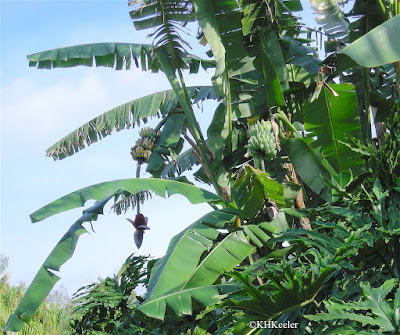I am writing a novel about Paraguay in 1630--because when I saw northern Argentina and Paraguay in the 1980s I was surprised by their natural history and history and have wanted to share their stories.
In trying to bring the 17th century to life, I have to describe what was there and that has been quite an adventure because there has been so much change.
Beginning in the 1500s, conquering and colonizing, European powers carried useful plants all over the world. To describe our world early in that process, I have to figure out what plants are native to the Americas and which were introduced. If it is native to the Americas, it will likely be new to Europeans. If it is from Africa or China, it may not yet be common in South America even if it is abundant there today.
For example, frangipani (Plumeria spp., dogbane family Apocynaceae) called the Indian temple tree, is native to Central America and the Caribbean. My characters probably had not seen it in Spain.
 |
| frangipani (Plumeria) |
Mangoes (Mangifera indica, sumac family Anacardiaceae), very common in the American tropics today, are from Asia.
 |
| mango tree (Mangifera indica) seen on Sint Eustacius in the Caribbean |
It is an ongoing challenge. Beaches...my photos all feature coconut palms (Cocos nucifera, palm family Arecaceae). But those are native to the western Pacific Ocean and probably were not widespread on Atlantic coasts as early as 1630.
 |
| coconut palm (Cocos nucifera) |
 |
| tropical almond, Terminalia catappa |
Bananas (Musa spp. banana family, Musaceae), seen everywhere in tropical America today, are native to Southeast Asia.
 |
| banana (Musa spp.) |
 |
| Star fruit growing in Costa Rica |
 |
| soursop (Annona) |
 |
| noni, Morinda citrifolia |
 |
| papaya (Carica papaya) |
 |
| casava (Manihot esculenta, poinsettia family, Euphorbiaceae) root and leaf |
For most of us, the plants of our childhoods are "normal" and often beloved. Likewise, we visit the tropics and fall in love with huge red flowers, enticing fragrances or large and dramatic leaves.
But the plants we are surrounded with are often gathered from around the world.
 |
| African tulip tree (Spathodea campanulata, catalpa family, Bignoniaceae) in Hawaii |
Do I want to throw out all those aliens? Probably not. But it has been eye-opening to see how much we have homogenized the world. So many of the plants remembered with fondness from Costa Rica are native to Bali and those remembered from Bali are native to Costa Rica.
From this blog:
More on banana: link
More on coconuts: link
More on papaya: link
More on plumeria (frangipani): link
References
Van Wyck, Ben-Erik. 2005. Food Plants of the World. Timber Press, Portland, Oregon.
Wikipedia and Missouri Plant Finder - checking spellings and scientific names.
Kathy Keeler, A Wandering Botanist
More at awanderingbotanist.com

No comments:
Post a Comment